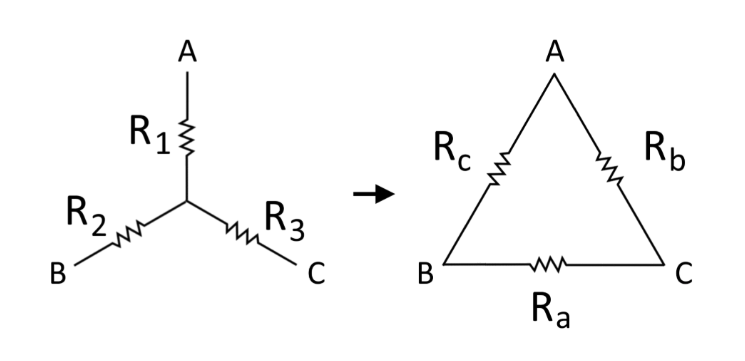1. What is Star-to-Delta Conversion?
Definition: Star-to-Delta conversion, also known as Wye-to-Delta or Y-Δ transformation, is a technique used in electrical engineering to convert a star (Y) configuration of resistors into an equivalent delta (Δ) configuration. This transformation simplifies the analysis of three-phase circuits.
Purpose: This calculator converts star-connected resistances into their delta equivalents, which is essential for simplifying complex three-phase circuits in power systems, electrical networks, and RF applications.
2. How Does the Calculator Work?
The calculator uses the following formulas for star-to-delta conversion:
Delta Resistances:
\[
\begin{aligned}
R_a &= \frac{R1 \cdot R2 + R2 \cdot R3 + R3 \cdot R1}{R1} \\
R_b &= \frac{R1 \cdot R2 + R2 \cdot R3 + R3 \cdot R1}{R2} \\
R_c &= \frac{R1 \cdot R2 + R2 \cdot R3 + R3 \cdot R1}{R3}
\end{aligned}
\]
Where:
- \( R_a \), \( R_b \), \( R_c \): Delta-connected resistances (in ohms, \( \Omega \))
- \( R1 \), \( R2 \), \( R3 \): Star-connected resistances (in ohms, \( \Omega \))
Steps:
- Enter the star-connected resistances \( R1 \), \( R2 \), and \( R3 \) in ohms.
- Click "Calculate" to compute the equivalent delta-connected resistances \( R_a \), \( R_b \), and \( R_c \).
- Results are displayed in ohms with 4 decimal places, or in scientific notation if less than 0.001.
3. Importance of Star-to-Delta Conversion
Star-to-Delta conversion is crucial for:
- Circuit Simplification: Converts complex three-phase networks into simpler forms for analysis.
- Power Systems: Facilitates the design and analysis of three-phase power systems by transforming impedances.
- RF Applications: Assists in impedance matching and network analysis in high-frequency circuits.
4. Using the Calculator
Examples:
- Example 1: Equal Star Resistances
- \( R1 = 10 \, \Omega \), \( R2 = 10 \, \Omega \), \( R3 = 10 \, \Omega \)
- Common term: \( 10 \times 10 + 10 \times 10 + 10 \times 10 = 300 \)
- \( R_a = \frac{300}{10} = 30.0000 \, \Omega \)
- \( R_b = \frac{300}{10} = 30.0000 \, \Omega \)
- \( R_c = \frac{300}{10} = 30.0000 \, \Omega \)
- Example 2: Unequal Star Resistances
- \( R1 = 5 \, \Omega \), \( R2 = 10 \, \Omega \), \( R3 = 15 \, \Omega \)
- Common term: \( 5 \times 10 + 10 \times 15 + 15 \times 5 = 50 + 150 + 75 = 275 \)
- \( R_a = \frac{275}{5} = 55.0000 \, \Omega \)
- \( R_b = \frac{275}{10} = 27.5000 \, \Omega \)
- \( R_c = \frac{275}{15} \approx 18.3333 \, \Omega \)
- Example 3: Small Resistances
- \( R1 = 2 \, \Omega \), \( R2 = 3 \, \Omega \), \( R3 = 4 \, \Omega \)
- Common term: \( 2 \times 3 + 3 \times 4 + 4 \times 2 = 6 + 12 + 8 = 26 \)
- \( R_a = \frac{26}{2} = 13.0000 \, \Omega \)
- \( R_b = \frac{26}{3} \approx 8.6667 \, \Omega \)
- \( R_c = \frac{26}{4} = 6.5000 \, \Omega \)
5. Frequently Asked Questions (FAQ)
Q: What is the difference between star and delta configurations?
A: In a star (Y) configuration, resistors are connected in an open "Y" shape with a common node, while in a delta (Δ) configuration, resistors form a closed loop in a triangular shape.
Q: Why perform star-to-delta conversion?
A: Converting a star configuration to delta can simplify the analysis of three-phase circuits, especially when dealing with parallel impedances or simplifying network calculations.
Q: Are the converted delta resistances always larger than the star resistances?
A: Yes, typically the delta resistances are larger because the conversion involves summing products of the star resistances, which increases the equivalent resistance.
Star-to-Delta Conversion Calculator© - All Rights Reserved 2025
 Home
Home
 Back
Back
